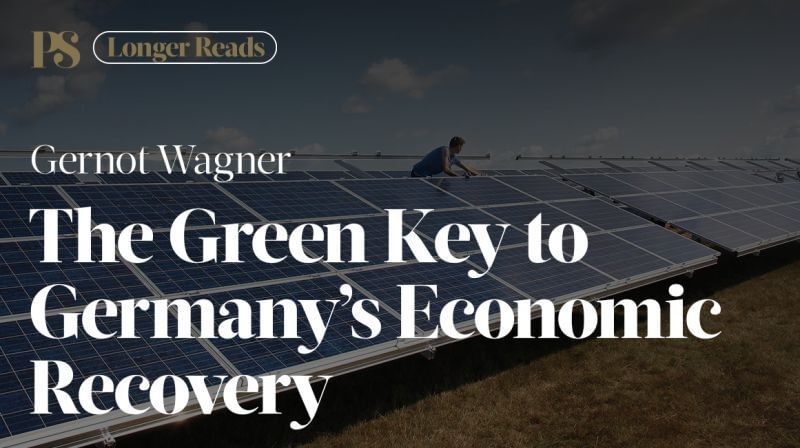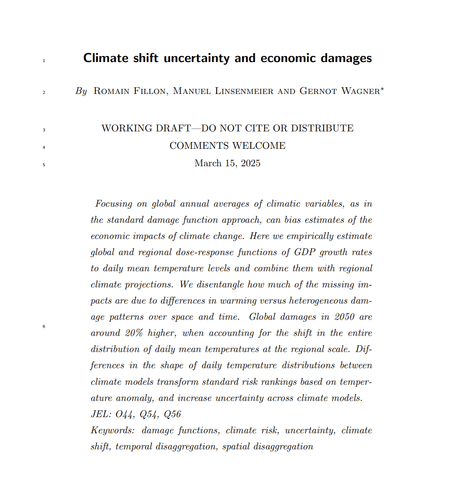A Big-Sky Plan to Cool the Planet
Pumping aerosols into the stratosphere may buy us more time, but it’s no substitute for cutting carbon emissions—and we still don’t know enough to do it responsibly.

Illustration: Harry Campbell
By Gernot Wagner and Martin L. Weitzman
Seriously addressing climate change means cutting carbon emissions and, ultimately, reducing the carbon already in the atmosphere. There’s no way around it. Another type of intervention, however, is increasingly garnering attention: solar geoengineering, that is, cooling the planet by making it reflect back more of the sun’s rays. It’s not a permanent solution to climate change, and it carries worrisome environmental and political risks of its own, but it’s an idea worth exploring.
The principle underlying solar geoengineering is simple enough: Brighter colors reflect more light and cool what’s underneath. That’s why houses in Mediterranean villages are often painted white. It’s also why scientists are so worried about the loss of polar sea ice, whose brilliant surfaces reflect solar radiation. Open water is darker and absorbs more sun and heat. In 1965, in the first report to a U.S. president on the effects of global warming, the one solution suggested to President Lyndon Johnson was solar geoengineering: attempting to brighten ocean surfaces on a grand scale.
‘Solar geoengineering is so potentially powerful that it turns the usual economics of climate change on its head.’
Since then, scientists have largely shifted their attention from the oceans to the skies. The most prominent and widely discussed basic scheme would involve spreading tiny reflective particles in the upper atmosphere.
How do we know this could work? Nature provides ample precedent. Major volcanic eruptions have often dramatically reduced global average temperatures. The eruption of Mt. Pinatubo in the Philippines in 1991 catapulted almost 20 million tons of sulfur dioxide into the stratosphere. As a result, global average temperatures in 1992 were almost a degree Fahrenheit lower.
But volcanic eruptions are typically massive one-off events, providing a rapid and temporary global cooling. Temperatures soon return to previous levels. Solar geoengineering would require a more deliberate and long-term approach.
Any practical program would need to start slowly, but the effects could be substantial over time. In a 2016 paper in the journal Earth’s Future, the Harvard scientists David W. Keith and Peter J. Irvine lay out a research hypothesis based on a proposal to offset half of the increase in global average warming from a particular date onward. The intervention they describe would ramp up, after a decade, to delivering perhaps a million tons of sulfate aerosols into the stratosphere each year. The impact would be unnoticeable to the naked eye, reflecting well under 1% of solar radiation back into space.
Putting that amount of materials into the skies may sound ambitious, but it could help to counter the warming effects of hundreds of billions of tons of emitted carbon dioxide. Such a scheme could not continue forever, of course. The only sensible approach would be to ramp it back down as progress is made in cutting carbon emissions.
Despite hundreds of peer-reviewed papers on solar geoengineering and an array of high-level scientific conferences, many questions about its feasibility and effects remain unanswered. But one thing has become abundantly clear: The costs of implementation would be relatively cheap—perhaps too cheap.
Our own rough estimates suggest that a concerted program—involving at first, say, a dozen specially designed high-flying planes to deliver aerosols into the stratosphere near the equator—would have startup costs of under $5 billion for the aircraft and necessary technical infrastructure. The biggest annual expense would be satellite monitoring and other scientific support systems, but none of that would add more than $2 billion a year. In the last year of a decade-long ramp-up, with as many as 30 planes flying, the annual cost could amount to under $10 billion.
Such sums are hardly negligible, but in context, they start to look small. The hope is that an expenditure of a few billion dollars a year could help to offset climate damages in the trillions of dollars.
‘The difficulty would not be motivating countries to deploy aerosols but stopping them from doing too much too soon.’
Solar geoengineering is so potentially powerful, in fact, that it turns the usual economics of climate change on its head. Though the benefits of lower carbon dioxide emissions are felt by all seven billion people on the planet, the costs are born by those cutting their emissions. That leads to a classic “free rider” problem, where nobody wants to go first unless compelled by policies such as carbon taxes or green subsidies. Countries also have an incentive to “free ride” on the actions of others, which is why measures like the 2015 Paris Agreement, which tries to induce signatories to do more than they otherwise would, are so important.
Solar geoengineering reverses this logic. Call it the “free driver” problem: The difficulty would not be motivating countries to deploy aerosols but stopping them from doing too much too soon. Without international agreements, the country determined to do the most might just get its way.
Dozens of countries might have the inclination and resources to play that role. The next time a “once-in-a-century” storm—now more frequent and intense because of global warming—devastates, say, the Philippines, one can imagine discussions there on whether the country should invest in solar geoengineering. Leaders might be remiss not to consider such a possibility and might well recruit other similarly situated countries to the cause.
The problem is that we simply don’t know enough to make any such decision responsibly.
For one, we don’t know which materials would be safest and most effective. Sulfate aerosols are featured in most plans, largely because they best match the known effects of volcanic eruptions. But they also contribute to depleting stratospheric ozone. Some preliminary research points to the possible use of calcium carbonate as an alternative. It has potentially better reflective properties for lowering temperatures, and it could help to restore ozone. Much more research needs to be done and may well identify other possibilities.
Perhaps the greatest concern about solar geoengineering is political, however: the fear that giving it serious attention will crowd out long-overdue steps to cut carbon pollution. It was precisely this concern, even among scientists, that marginalized solar geoengineering research for more than four decades after the 1965 report to President Johnson.
The taboo was broken in 2006 when Paul Crutzen, who had earlier won a Nobel Prize in chemistry for work leading to the discovery of the ozone hole, came out in favor of research on the subject. He presented solar geoengineering as a possible way to deal with a “Catch-22” playing out in the lower atmosphere: Cuts in sulfur dioxide pollution in recent decades have been a great boon to human health, saving millions of lives. But the pollutant also has the unintended effect of helping to cool the planet. Further progress in eliminating it will cause temperatures to rise. A 2016 paper in the journal Nature Geoscience estimated that Europe’s dramatic cuts in sulfur dioxide pollution since 1980 had increased Arctic temperatures by almost a degree Fahrenheit.
Solar geoengineering may indeed help us to escape this unfortunate trade-off, even as it creates others. Whatever one’s feelings about the technology, however, ignoring it is not an option. The “free driver” effect could simply prove too strong.
Making the planet more reflective cannot be a replacement for cutting carbon pollution. At best, it is a supplement to other efforts to combat climate change, and it’s an imperfect one at that—a drug that merely moderates dangerous symptoms. The permanent solution is a regimen of diet and exercise.
Dr. Wagner is a research associate and lecturer at Harvard and co-director of the university’s Solar Geoengineering Research Program. Dr. Weitzman is a professor of economics at Harvard. They are coauthors of “Climate Shock: The Economic Consequences of a Hotter Planet” (2015).
This essay appeared in the February 17th, 2018, print edition of the Wall Street Journal. Reprinted here with permission.


